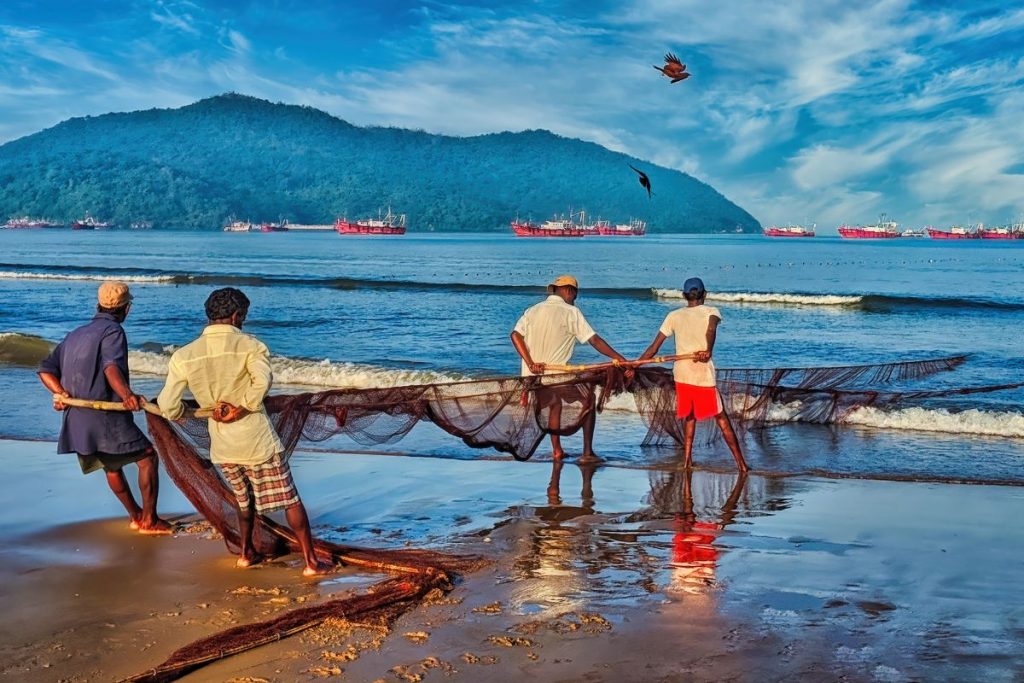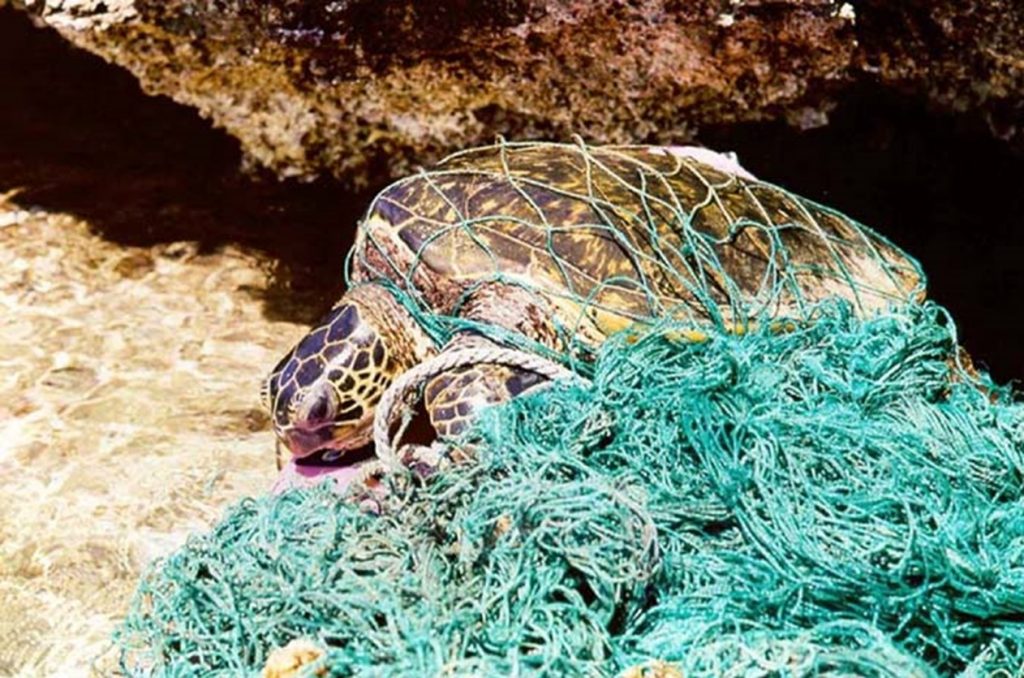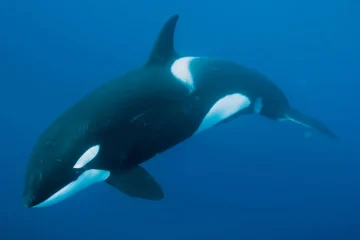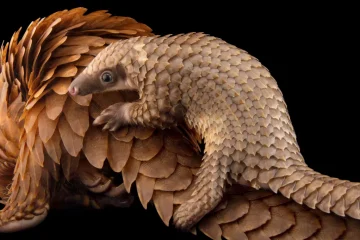
Figure 1: An industrial setting in the fisheries industry
“One-fifth of humankind depends on fish to live. Today 70 percent of the fish stock is over-exploited. According to FAO if we don’t change our system of fishing the main sea resources will be gone in 2050. We don’t want to believe what we know.”
- Yann Arthus Bertrand
(French environmentalist, activist, journalist, and photographer)
As per the quote above, fisheries and aquaculture play an immensely important role in the livelihood of people and serve as an aspect where biodiversity, environment, economy, industry, etc. act together. The Earth, “The Blue Planet”, being covered by water for 71% of its surface, hosts vast potential for promoting sustainable fisheries and aquaculture. However, the threats imposed by fisheries, such as overexploitation, loss of biodiversity, industrial waste and chemical removals, etc., and their adverse effects on respective fields, ring an alarm in understanding not only the importance of aquatic ecosystems but also the importance of fisheries as an industry, to promote the establishment of a more sustainable fishery industry and practices. As an attempt to commemorate the importance of fisheries as well as sustainability, World Fisheries Day is celebrated on the 21st of November annually, with the theme of “Highlighting the critical importance of healthy eco-systems to ensure suitable fish stock in the world”, in 2023.
What are fisheries, and what is the status of fisheries in the world?
In general, “Fisheries” refers to the enterprise of raising and harvesting fish and other aquatic life: including molluscs, crustaceans, etc. Commercial fisheries involve either wild fisheries or fish farms, either as freshwater systems or marine systems. The Food and Agriculture Organization of the United Nations defines the term “fishery” as “an activity leading to the harvesting of fish. It may involve the capture of wild fish or raising fish through aquaculture”, which is defined in terms of “people involved, species or type of fish, area of water or seabed, method of fishing, class of boats, purpose of the activities, or a combination of the foregoing features.” Mainly, this involves a wide variety of species belonging to finfish, mollusks, crustaceans, and echinoderms. Major finfish species include tuna, salmon, herrings, etc., while squibs, shrimp, oysters, crabs, and scallops represent the other categories.
Fisheries can be divided into three major categories based on the purpose of fishing: commercial, recreational, and subsistence fisheries.
Commercial fisheries refer to the catching of fish and other seafood for commercial benefit (mostly with wild fisheries). It is done either large-scale or small-scale.
Recreational fisheries refer to fishing done for leisure, exercise, or competition purposes rather than for commercial purposes. Angling and spearfishing are some examples of recreational fisheries.
Subsistence fisheries refer to fishing for survival. It comprises many small-scale, low-technology, low-capital fishing practices done by individual fishing households.

Figure 2: Commercial, recreational, and subsistence fisheries
Apart from that, fisheries can be further categorized based on the waters in which they are conducted: saltwater (which comprises 90% of the fishery industry) and freshwater (which comprises 10% of the industry). Moreover, the majority of the fisheries are conducted as “wild fisheries”, especially in commercial settings, and less as “farmed fisheries” in aquacultures.
The fishery is a prominent global industry that directly or indirectly affects the livelihood of approximately 500 million people in the world. In 2016, the highest total fish production of nearly 171 million tons was recorded, with the record for the highest per-capita fish consumption of 20.3 kg annually. Moreover, China has accounted for the highest fish production over the past few years. For 2018–2030, it is predicted by the FAO that although world fish production, consumption, and trade are expected to increase, the rate of growth will decline over the given period. However, trade in fish is expected to increase more slowly than in the last decade, but the share of fish to be exported is expected to remain stable.
Moreover, in recent years, the advent and advancements in Blue Biotechnology have enhanced the production and sustainability of fisheries considerably.
The Status of Fisheries in Sri Lanka
Being an island with an Exclusive Economic Zone (EEZ) of 510,000 km2, Sri Lanka has enormous potential to pioneer in the fisheries industry, both in marine and inland waters. Tuna, swordfish, prawns, shrimps, mud and blue swimming crabs, lobsters, sea cucumbers, barramundi fish, etc. can be considered major categories of fishery products from Sri Lankan coastal waters. The well-established fishery industry in Sri Lanka has been reported to attain a total fish production of 505.830,000 Mt (with 415,490 Mt from marine fisheries and 90,340 Mt from Inland Fisheries) in the year 2019, which possesses 22 major fishery harbours, 883 minor fishing landing centers, etc.

Figure 3: Exclusive Economic Zone of Sri Lanka
The fisheries sector in Sri Lanka can be subdivided into three major sectors: shore and deep-sea fisheries, coastal fisheries, and inland fisheries and aquaculture. Sri Lanka hosts extensive freshwater and brackish water resources, along with a wide diversity of coastal habitats, including estuaries and lagoons, mangroves, sea-grass beds, salt marshes, etc. Apart from domestic consumption, Sri Lankan fisheries extend up to exportation to France, Italy, Germany, Japan, etc.
Impacts of Fisheries: How Does It Affect?
As already mentioned above, fishing has a considerable impact on the economy, social structures, and the environment. Irrespective of its economic and social importance, fisheries contribute to a wide array of ecological issues, including overexploitation (overfishing), impacts on associated and dependent species, water pollution, impacts on coral reefs, etc., fisheries-induced evolution, bycatch, etc.
With the growing world population, over the years the rate of exploitation of marine resources (mainly) in fisheries has increased, which has increased the rate of natural replenishment of fish resources. Moreover, overfishing has led to an over-exhaustion of other resources. Moreover, the removal of top predators in aquatic food chains (such as sharks) can result in an imbalanced increase of aquatic organisms representing the lower levels in the food chain, imposing adverse effects on maintaining food chains and populations of associated species, including endemic and endangered species. This disrupts ecological services in both marine and in-land ecosystems. Fishing also brings out an evolutionary impact, since fishing pressure can induce changes in shape, size, etc. of the fish preferred by selection.
Other than that, due to harmful chemicals, technologies used and the generation of heat during fishing practices, fisheries tend to impact the coral reefs and other sediments adversely. These (along with physiological and psychological stress) can also interfere with the normal breeding patterns of aquatic animals, and their communications as well, leading to the decline of other species which are not usually targeted during fishing as well. Blast fishing (where explosives are used), cyanide fishing, and bottom trawling are a few examples of such harmful fishing practices.
Another issue with fishing is bycatch. Bycatch refers to the proportion of fish that is not of the target species. Generally, per pound of target species caught, 5 pounds of unintended species are caught and discarded. This occurs due to the lower specificity of fishing gear for target species. Moreover, the accumulation and release of marine debris pose threats to the sustainability of marine life. This includes plastic which drastically increases the mortality rates of aquatic life. Other than that shark finning, shark culling, etc. also contribute to such adverse effects.

Figure 4: A turtle entangled in a fishing net and debris
Apart from that Illegal, Unreported, and Unregulated fishing (IUU) also enhances the above adverse effect, confirming the need for proper and sustainable practices in fisheries.
Stepping Towards Sustainable Fisheries
Apart from its influence on the economy, society, and environment, fisheries face a wide range of challenges including challenges due to global warming, overfishing, overcapacity, Illegal, Unreported, and unregulated (IUU) fishing, habitat degradation, and pollution, etc. which threatens the sustainability and the long-term viability of fisheries industry. Therefore, proper measures both locally and globally should be implemented to address these issues, since fisheries affect the livelihoods of millions of people in the world. Sustainable Development Goal 14: “Life Below Water” addresses the focus on preserving coastal ecosystems and supporting more sustainable fisheries and aquaculture practices.
Improved fishery management is a key practice in attaining sustainability, which requires robust and scientific data, well-defined catch limits, and effective enforcement mechanisms. This prevents marine and inland aquatic resources from over-exploitation and can be accompanied by other law and policy enforcement, etc. Moreover, the incorporation of more efficient and precise technologies in fishing, the maintenance of aquaculture rather than depending on natural aquatic resources (especially for inland freshwater fisheries), the incorporation of blue-biotechnological concepts such as genetic engineering, etc. for higher yields with lower damage to the eco-systems, etc. can be considered appropriate methods in fisheries management. Combating IUU fishing requires international cooperation and strong political support, including port monitoring, control and surveillance methods, etc. The establishment of government bodies to monitor fisheries and their management, proper law enforcement, inculcating the importance of sustainability in fisheries, especially in coastal and other fishery-associated communities, etc. can also ensure another step towards sustainability.
As a country with fisheries holding an important proportion of its economy, it has several government and semi-government organizations, NGOs, and other non-profit organizations dedicated to the maintenance of sustainability of the fisheries industry, including:
National Aquatic Resources Research and Development Agency (NARA): for research and development in fisheries
National Aquaculture Development Authority (NAQDA): for the development and management of all freshwater resources in the country It also promotes the development of aquaculture and sea farming.
Ceylon Fisheries Cooperation: For the maintenance of cold storage facilities and the sale of fishery by-products.
Ceylon Fisheries Harbor’s cooperation: delivers quality fishery-harbour-related services and provides the fishing community with modern infrastructure and facilities.
Department of Fisheries: Management, regulation, conservation, and development of fisheries and aquatic resources
World Fisheries Day
As an approach to sustainable fisheries, World Fisheries Day is celebrated annually on 21st November, across the world, with the goals of highlighting the importance of sustainable stocks of fisheries in the World, strengthening human rights for the small-scale fishing communities, making a true difference in the working conditions of fishing communities and to eliminate illegal, unreported and unregulated fishing. Following World Fisheries Day, many forums, awareness sessions, research and innovation showcases, educational programs, exhibitions, policy discussions, etc. are organized to enhance the awareness of the general public and fisheries community of the importance of sustainable fisheries and aquaculture. In 2023, today the global community celebrates World Fisheries Day with the theme of “Celebrate fisheries and aquaculture Wealth”, highlighting the importance of healthy aquatic ecosystems for better livelihood and economic opportunities.
Therefore, as mindful and responsible global citizens, let’s cast the net with the concepts of sustainability for better fisheries in a healthy aquatic ecosystem.
Written by:
P.K.D. Chathumini Yasara,
3rd Year Undergraduate,
Immunology and Integrative Molecular Biology
Faculty of Science,
University of Colombo.
References:
- 3. FISHERIES IMPACT ON THE ECOSYSTEM. (2021). https://www.fao.org/3/y4773e/y4773e05.htm
- Capabilities of the fisheries industry in Sri Lanka. (2021, November 30). https://www.srilankabusiness.com/buyers/industry-capability-profile/seafood-products.html
- Crespo, G. O., & Dunn, D. C. (2017). A review of the impacts of fisheries on open-ocean ecosystems. Ices Journal of Marine Science, 74(9), 2283–2297. https://doi.org/10.1093/icesjms/fsx084
- Export Development Board Sri Lanka. (2022). Industry Capability Report: Sri Lankan Fisheries sector. In https://www.srilankabusiness.com.
- Fisheries Latest data. (2023). Retrieved November 16, 2023, from https://www.greenfacts.org/en/fisheries/index.htm#1
- Malik, H. (2021, September 28). WORLD FISHERIES DAY – November 21, 2023 – National Today. National Today. https://nationaltoday.com/world-fisheries-day/
- The Editors of Encyclopaedia Britannica. (2023, November 3). Fishery | Sustainable, Aquaculture, Conservation. Encyclopedia Britannica. https://www.britannica.com/topic/fishery
Image Courtesy:
- Title Image: https://biturl.top/UfANZ3
- 1st Content Image: https://biturl.top/iMF7Nv
- 2nd Content Image: https://biturl.top/EzQJvm
- 3rd Content Image: https://biturl.top/22YVRj



0 Comments